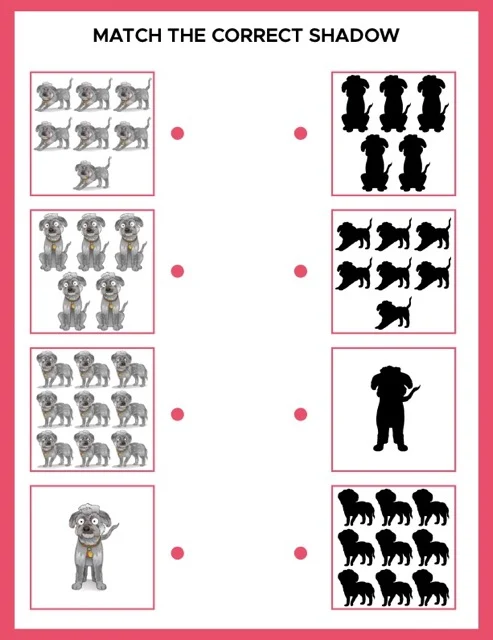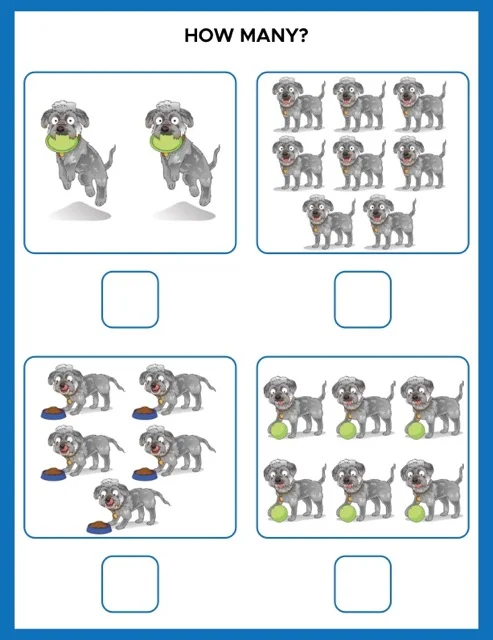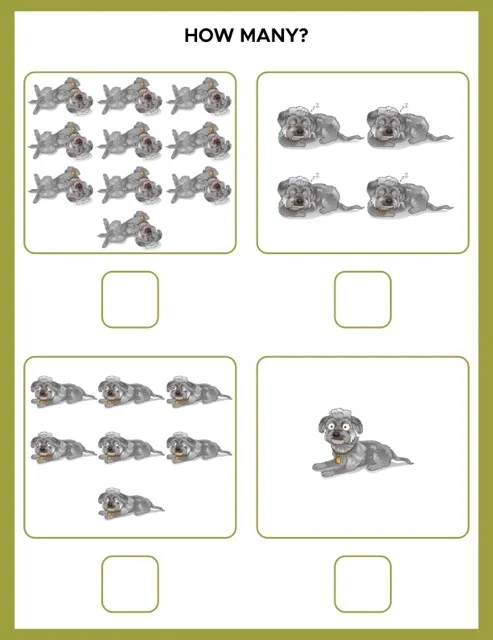Math Fun with Abby: A Review
This document reviews "Math Fun with Abby," a Hindi-language workbook designed to teach preschool and kindergarten children basic math skills. The workbook uses a visually engaging, hands-on approach with colorful images and relatable objects to cover counting, number recognition, addition, graphing, and comparison. While effective for Hindi-speaking children, its limitations include its language restriction and its potential incompatibility with certain learning styles. Suggestions for improvement include translation into other languages and the creation of a digital version.
Math Fun with Abby: Hindi Workbook Review
Briefing Doc: "Math Fun with Abby" Workbook Review
Target Audience: Preschool and Kindergarten-aged children
Language: Hindi
Core Math Skills Targeted:
●
Counting: Activities range from counting single digits to quantities over ten.
●
Number Recognition: Visual exercises associate numerals (in Hindi) with their corresponding quantities.
●
Basic Addition: Simple addition problems are introduced visually.
●
Graphing: Children represent counted data on simple charts, developing early data visualization skills.
●
Comparison: Activities focus on identifying bigger and smaller groups of objects, building understanding of size and quantity comparisons.
Teaching Approach:
"Math Fun with Abby" utilizes a visually engaging and hands-on learning approach. Key elements include:
●
Colorful Images: The workbook is filled with colorful images of animals and toys to capture children's attention and make abstract mathematical concepts more relatable.
●
Relatable Objects: Using familiar objects helps children connect math concepts to their everyday experiences, making learning more meaningful.
●
Hands-on Activities: Activities like matching, coloring, and circling provide tactile learning experiences that reinforce learning and keep children engaged.
Activity Types: (as seen in sample pages)
●
Counting and Graphing: Children count pictured animals and mark their findings on a simple chart. This reinforces both counting and early data representation.
●
Matching: Activities include matching numerals (in Hindi) to the corresponding number of pictured objects.
●
Comparing: Activities require children to circle the group with more or fewer animals, developing size and quantity comparison skills.
Workbook Structure:
While not explicitly stated, the workbook appears to progress gradually in complexity. Initial activities focus on basic counting and number recognition, with later exercises introducing larger numbers, addition, and more intricate graphing.
Potential Uses:
●
Homeschooling: Can serve as a structured curriculum for introducing foundational math concepts.
●
Supplementary Learning: Activities can complement traditional classroom math lessons and provide additional practice.
●
Engaging Practice: The colorful and interactive format makes learning math more enjoyable and accessible for young learners.
Required Materials:
●
Crayons or colored pencils
●
Pencils
●
Optional: Small objects like buttons or toys for use as counters.
Limitations:
●
Language: Currently available only in Hindi (based on provided sample pages). This limits accessibility for non-Hindi speaking children.
●
Individual Learning Styles: Workbook format might not be suitable for all learning styles. Some children may benefit more from interactive games, digital tools, or other hands-on activities.
Adaptation and Expansion:
●
Translation: Translating "Math Fun with Abby" into other languages would broaden accessibility and inclusivity.
●
Digital Version: Developing a digital version with interactive elements could further enhance engagement and cater to different learning styles.
Overall Impression:
"Math Fun with Abby" appears to be a well-designed and engaging workbook for introducing fundamental math concepts to preschool and kindergarten-aged children. The visual approach, use of relatable objects, and variety of hands-on activities are likely to be effective in making early math learning enjoyable and accessible.
Math Fun with Abby: A Preschool Math Workbook
Math Fun with Abby FAQ
1. What age group is "Math Fun with Abby" designed for?
"Math Fun with Abby" appears to target preschool and kindergarten-aged children. The activities focus on fundamental math concepts like counting, number recognition, and basic addition. The use of colorful visuals and relatable objects like animals suggests a focus on early learners.
2. What math skills does "Math Fun with Abby" aim to develop?
The workbook aims to develop several foundational math skills, including:
●
Counting: Activities encourage counting objects, from single digits to quantities over ten.
●
Number Recognition: Exercises help children visually recognize and associate numerals with their corresponding quantities.
●
Basic Addition: Simple addition problems are introduced using visuals and grouping techniques.
●
Graphing: Children learn to represent counted data on simple graphs, introducing data visualization.
●
Comparison: Activities ask children to identify bigger and smaller groups of objects, introducing concepts of size and quantity comparison.
3. What is the teaching approach used in "Math Fun with Abby"?
"Math Fun with Abby" employs a visual and hands-on learning approach. The workbook heavily relies on colorful images and relatable objects like animals and toys to engage children and make abstract mathematical concepts more concrete.
4. What types of activities are included in "Math Fun with Abby"?
The workbook features various activities designed to make learning math engaging and interactive. These include:
●
Counting and Graphing: Children count objects and record their findings on simple graphs.
●
Matching: Activities involve matching numerals to corresponding quantities or visual representations.
●
Coloring: Coloring activities reinforce number recognition and counting skills.
●
Circling: Children circle groups of objects based on size comparisons, fostering understanding of "bigger" and "smaller."
5. How can parents and educators use "Math Fun with Abby" effectively?
"Math Fun with Abby" can be used in various settings:
●
Homeschooling: The workbook provides a structured approach to introducing math concepts to young learners.
●
Supplementary Learning: The activities can complement classroom learning and provide additional practice.
●
Fun and Engaging Practice: The colorful and interactive format makes learning math enjoyable for children.
6. Does "Math Fun with Abby" require any special materials?
Most activities in the workbook likely require basic supplies readily available at home or in a classroom, such as:
●
Crayons or colored pencils
●
Pencils
●
Possibly counters (small objects for counting)
7. Are there different difficulty levels within "Math Fun with Abby"?
While specific difficulty levels are not explicitly stated, the workbook appears to progress gradually in complexity. Early activities focus on counting small quantities and basic number recognition, while later exercises introduce slightly larger numbers, addition, and more complex graphing.
8. Is "Math Fun with Abby" available in languages other than English?
Based on the provided sample pages, the text in the workbook is in English. Availability in other languages would require confirmation from the publisher or creator.
Math Fun with Abby Study Guide
Math Fun with Abby Study Guide
Short Answer Questions (2-3 sentences each)
1.
What is the primary age demographic for "Math Fun with Abby"?
2.
Identify three core math skills targeted by this workbook.
3.
Describe the visual learning approach employed in "Math Fun with Abby".
4.
Name two types of activities featured in the workbook.
5.
How might "Math Fun with Abby" be utilized in a homeschooling environment?
6.
What common household items might be helpful when using this workbook?
7.
How does "Math Fun with Abby" address varying levels of mathematical understanding?
8.
Are there any indications of the workbook's availability in languages besides English?
9.
Based on the provided sample pages, what language does "Math Fun with Abby" appear to utilize?
10.
What type of counting activity is depicted in the provided sample pages?
Short Answer Key
1.
"Math Fun with Abby" is primarily designed for preschool and kindergarten-aged children, focusing on fundamental math concepts through colorful visuals and relatable objects.
2.
The workbook aims to develop skills in counting, number recognition, and basic addition. Other skills addressed include graphing and size comparison.
3.
"Math Fun with Abby" uses a highly visual approach, incorporating colorful images of animals and toys to make abstract mathematical concepts more concrete and engaging for young learners.
4.
The workbook includes activities like matching numerals to quantities, counting and graphing objects, and circling groups based on size comparisons.
5.
In a homeschooling setting, "Math Fun with Abby" can serve as a structured curriculum for introducing foundational math concepts, providing a series of engaging exercises for young learners.
6.
Helpful household items include crayons or colored pencils for coloring activities and pencils for writing. Small objects like buttons or toys could be used as counters.
7.
While specific difficulty levels aren't explicitly stated, the workbook appears to progress gradually in complexity, starting with basic counting and number recognition before introducing larger numbers, addition, and more intricate graphing.
8.
Based on the provided information, there's no indication of availability in languages other than English. Confirmation would be needed from the publisher.
9.
The sample pages clearly indicate that "Math Fun with Abby" is written in Hindi.
10.
The sample pages show a counting and graphing activity, where children count the depicted animals and mark their findings on a simple chart.
Essay Questions
1.
Discuss the importance of a visually engaging approach when teaching math concepts to preschool-aged children. How does "Math Fun with Abby" utilize this approach?
2.
Explain how "Math Fun with Abby" can be used as a supplementary tool to enhance classroom learning. Provide specific examples of how the workbook's activities might complement traditional math lessons.
3.
Analyze the effectiveness of incorporating hands-on activities like matching, coloring, and circling in the development of early math skills. Refer to specific examples from "Math Fun with Abby."
4.
Evaluate the potential benefits and limitations of using a workbook format for teaching math to young children. Consider factors like engagement, individual learning styles, and the role of adult guidance.
5.
How might "Math Fun with Abby" be adapted or expanded to address the needs of children with diverse learning abilities or cultural backgrounds?
Glossary of Key Terms
●
Numeral: A symbol used to represent a number.
●
Quantity: The amount or number of something.
●
Graphing: Visually representing data using charts or diagrams.
●
Comparison: Examining two or more things to identify similarities and differences, such as determining which is bigger or smaller.
●
Hands-on Learning: Engaging in activities that involve physical manipulation and sensory experiences.
●
Supplementary Learning: Educational materials or activities that enhance and reinforce primary instruction.
●
Homeschooling: Educating children at home rather than in a traditional school setting.
●
Foundational Math Skills: Basic mathematical concepts that serve as building blocks for more complex learning.
●
Curriculum: A planned course of study.




























